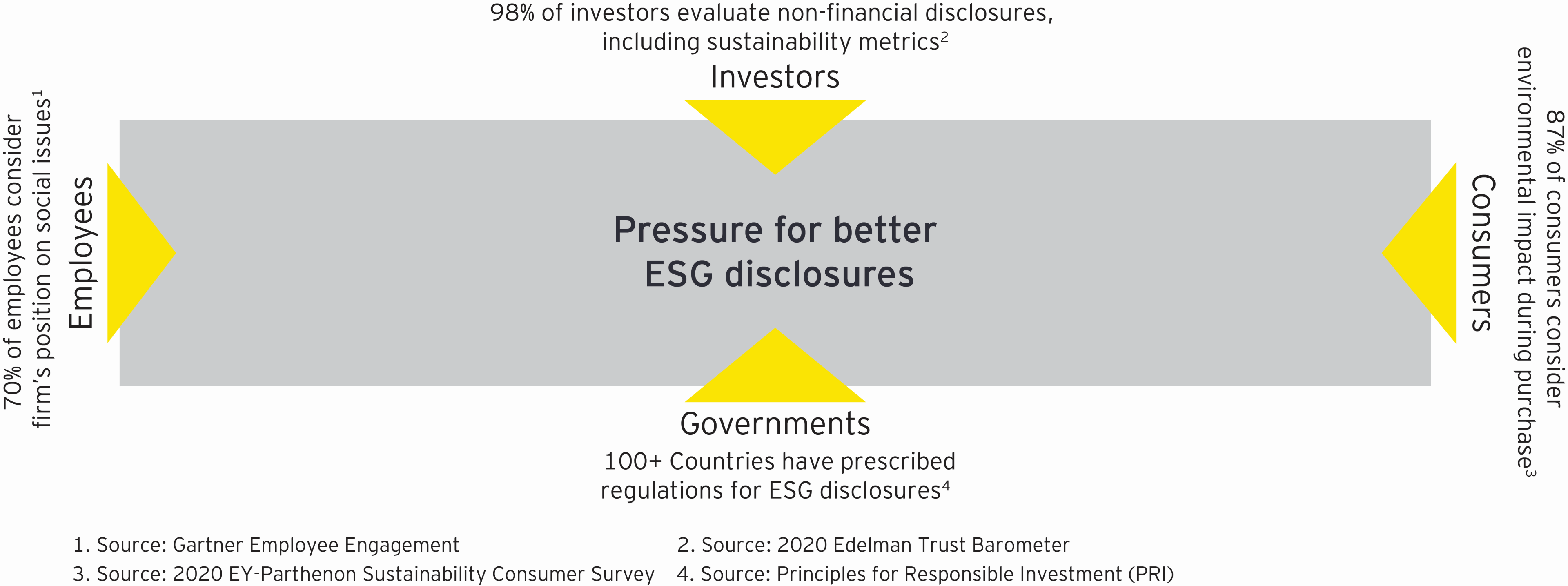
Chapter 1
GCCs are increasingly driving the organization’s ESG agenda
A centralized ESG function operating from a GCC can accelerate growth to meet the organization’s ESG goals.
GCCs have increasingly become centers of efficiency, innovation, and modern business practices. They can leverage their capability to standardize and centralize global operations, policy, procedures and data to streamline ESG reporting and compliance.
- Centralized regulatory compliance: Organizations having business across geographies would be in a position to leverage economies of scale of centralizing operations for an evolving regulatory landscape.
- Integrations of siloed activities: While organizations have been running the ESG agenda for a few years now, activities have largely been siloed, leading to issues like information asymmetry and lack of program governance.
- Data consistency and integrity: ESG programs would also involve third party participation like implementation partners, assurance partners, etc. Centralizing the ESG function can help manage partners and solve data quality issues, ensuring a single source of truth for reporting and compliance.
- Program governance: A central team can help with industry benchmarking, setting up an ESG framework and identifying KPIs to develop goals and implement initiatives. This will allow for greater accountability and robust tracking of organizations’ frameworks for ESG reporting.


Chapter 2
The four levels of GCC ESG maturity
Depending on maturity, GCCs can support ESG from basic activities to industry leading processes.
A centralized ESG function housed within a GCC can support varied kinds of activities, ranging from running basic activities to industry leading ESG business processes.
There are four levels of maturity, when defining the ESG GCC operating model:
- Basic: At an early stage, the GCC performs isolated activities like ESG reporting and regulatory compliance. These activities require minimum collaboration or communication with other business functions and can be carried out independently.
- Established: An established GCC deals in activities which involve internal collaboration with other business functions. Such activities in an ESG context include setting up and tracking of ESG goals, internal stakeholder reporting, data management, etc.
- Advanced: An advanced GCC deals in activities which involve external stakeholder management and can carry out most of the activities required for an ESG function. Some of these activities include ESG disclosures and reporting, data governance, ESG assurance, etc.
- Leading: A leading ESG function performs many more activities like ESG analytics, branding, sourcing advisory, etc. These are activities that require a great deal of maturity and support from other functions but are owned by the GCC ESG team.


Chapter 3
Creating long-term value by building a centralized ESG function
How a central ESG function would work within the organization.
GCCs are a ready and effective platform for encouraging ESG initiatives. Maximum value is derived when ESG is viewed to create long-term value for the business and society. A centralized ESG team is designed for end-to-end accountability of ESG activities, including handling sustainability data, compliance, reporting, design, and implementation of new initiatives.
Within a GCC, the support that a central ESG function can provide in streamlining the workflow operations, updating ESG regulations, framework, standards to irradicate inconsistencies, identification, and personalization of processes, is crucial. These can be achieved by collating ESG information from multiple source points through API gateways, and identification and personalization of processes. This would require the central team to work with multiple teams across the organization, and this would be possible with the following structure:

- The Regulatory and Compliance team helps in the risk assessment, conducting due diligence, tracking evolving compliances and requirements, articulate sustainability goals of the organization and provide constructive feedback for training support.
- The Implementation teams act as the action owners of the initiatives and coordinate with the global stakeholders in carving an implementation plan together with remediation plans. They oversee end-to-end program management and track progress of these initiatives.
- The Data and technology teams take advantage of the existing technology layer and acts as an enabler by developing tools, setting data platforms and dashboards for executive view. They manage and track the implementation of data governance and solution models.
All these teams work in tandem with each other and the other established work streams to achieve ESG goals and the larger business purpose.
How EY has supported GCCs with ESG centralisation and transformation?
EY has worked with GCC clients to support their global sustainability agenda. A couple of case studies from this experience are described below:
| Client description | Leading Agribusiness and Food company | International Energy company |
| Scope | EY successfully created a data to insight solution, housed in a GCC for five sustainability KPIs across 95 global locations | EY worked with the procurement team, ESG and sustainability verticals to extract data at a product level and initiate a GHG emission computation for two countries based in the GCC |
| Approach |
|
|
| Outcome |
|
|
(Rohan Devraj (Senior Consultant), Paraini Soren (Consultant), Pooja Poddar (Consultant), Maheswaran R (Senior Manager) also contributed to the article.)
Latest GCC articles
Summary
GCCs are best placed to drive the corporate ESG agenda and transform the traditional ways of working of the function. With the use of technology and expanding scope of the function, this provides benefits of centralization too.



